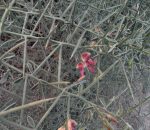
Also known as Caspian manna and Persian manna plant, this deciduous shrub is indigenous to temperate and tropical Eurasia and the Middle East where it grows in both wetlands and deserts. It is a member of the pea family, Fabaceae, that also includes beans, mimosa, and black locust. The low scrubby plant grows up to 6.7′ tall and has an extensive creeping root system and many much- branched stems with thin hairy twigs and an abundance of long, slender, axillary spines. The gray-green leaves are wedge-shaped, hairless, and 1/4 inch long. In summer, axillary racemes of pink to maroon pea-like flowers appear and give way to half moon-shaped, brown or reddish pods with constrictions between the mottled brown seeds. During the warm part of the day the stems and leaves produce a sweet gummy exude that hardens on contact with air and may be collected and eaten. Camel thorn has been valued as a folk medicine and is consumed as a famine food. It is unpalatable to animals and considered an invasive weed in some areas, especially grazing land. The genus name, Alhagi, is derived from the Arabic word meaning pilgrim. The specific epithet, maurorum, is the Latin word meaning of the Moors.
Type: Deciduous shrub
Outstanding Feature: Wide soil tolerance
Form: Scraggly mound
Growth Rate: Rapid
Bloom: Racemes of pink to maroon flowers in summer
Size: 6.7′ H
Light: Full sun
Soil: Wide soil tolerance including sandy, rocky, dry, and saline soil; thrives when growing near a source of water.
Hardiness: Zones 6-10
Care: Control invasiveness
Pests and Diseases: Unavailable
Propagation: Seed, division of rhizomes, cuttings of young shoots
Outstanding Selections: Unavailable
Photo Credit: Wikimedia Commons